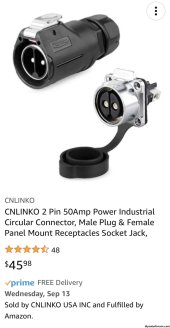I'm building an off-grid solar system for an equipment garage. Its rural, and the county I'm in does not have electrical inspections. Code compliance is not an concern, but safety is. This video got me thinking about the value of my batteries and inverter being portable. I plan to cut up an aluminum server rack and weld it together such that it will sit stable on the floor without being bolted down, holding 2-3 rack mount batteries and the inverter. The idea is, if I ever need a portable power supply, I can unhook it and set in the back of the truck (for example, when we build a tiny house in the next few years).
So - I'd like to have the inverter "plug in" to a distribution panel in the garage.
If there are any norms for what NEMA plugs to use, I'd like to follow the norms.
system details:
12 x 305w Hyandai panels (6 series, 2 parallel = around 250vdc 19 amps),
1 x eg4 3kw 120v all-in-one inverter/charge contorller
2 x SOK 48v batteries
For the 120v line, I'm thinking NEMA L5-30 is appropriate because that's a 30a, 120v, twist lock. I'd get a generator inlet plug for the breaker box in the garage, so the inverter plugs into it like a generator.
I'd like to have some 48vdc things in the garage (security cameras, wifi, etc). That will be 1-2 amps. I'm thinking SAE 2 pin?
What I'm unsure of, is what is appropriate for the 250v / 20a DC from the solar panels? Any 20a rated plug would "work", but I'm wondering if there's any preferred or recommended options.
So - I'd like to have the inverter "plug in" to a distribution panel in the garage.
If there are any norms for what NEMA plugs to use, I'd like to follow the norms.
system details:
12 x 305w Hyandai panels (6 series, 2 parallel = around 250vdc 19 amps),
1 x eg4 3kw 120v all-in-one inverter/charge contorller
2 x SOK 48v batteries
For the 120v line, I'm thinking NEMA L5-30 is appropriate because that's a 30a, 120v, twist lock. I'd get a generator inlet plug for the breaker box in the garage, so the inverter plugs into it like a generator.
I'd like to have some 48vdc things in the garage (security cameras, wifi, etc). That will be 1-2 amps. I'm thinking SAE 2 pin?
What I'm unsure of, is what is appropriate for the 250v / 20a DC from the solar panels? Any 20a rated plug would "work", but I'm wondering if there's any preferred or recommended options.




